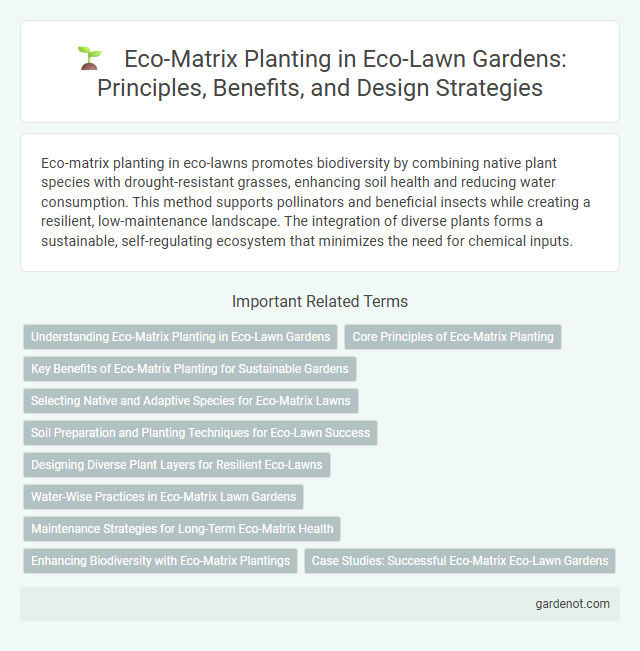Eco-matrix planting in eco-lawns promotes biodiversity by combining native plant species with drought-resistant grasses, enhancing soil health and reducing water consumption. This method supports pollinators and beneficial insects while creating a resilient, low-maintenance landscape. The integration of diverse plants forms a sustainable, self-regulating ecosystem that minimizes the need for chemical inputs.
Understanding Eco-Matrix Planting in Eco-Lawn Gardens
Eco-matrix planting in eco-lawn gardens integrates diverse native species to enhance soil health, promote biodiversity, and reduce water consumption. This sustainable planting method establishes resilient ground cover that minimizes the need for chemical inputs and supports local ecosystems. By mimicking natural plant communities, eco-matrix planting improves lawn sustainability and ecological balance.
Core Principles of Eco-Matrix Planting
Eco-matrix planting centers on enhancing biodiversity by integrating native plant species that support local ecosystems and soil health. It employs strategic layering of vegetation to maximize habitat complexity and promote natural pest control through ecological balance. Water efficiency and minimal maintenance are core principles, ensuring sustainable growth while reducing environmental impact.
Key Benefits of Eco-Matrix Planting for Sustainable Gardens
Eco-matrix planting enhances soil health by increasing biodiversity and improving water retention, which reduces irrigation needs in sustainable gardens. This approach promotes natural pest control and supports pollinators, fostering a balanced ecosystem. By integrating native and drought-resistant species, eco-matrix planting lowers maintenance costs and enhances garden resilience against climate change.
Selecting Native and Adaptive Species for Eco-Matrix Lawns
Selecting native and adaptive plant species for Eco-matrix lawns enhances biodiversity, promotes soil health, and reduces maintenance requirements. Species such as buffalo grass, blue grama, and fine fescues are well-suited for diverse ecological conditions, providing drought tolerance and natural pest resistance. Incorporating a mix of native grasses and wildflowers maximizes ecosystem services like pollinator support and carbon sequestration, creating resilient and sustainable green spaces.
Soil Preparation and Planting Techniques for Eco-Lawn Success
Effective soil preparation for Eco-matrix planting involves loosening compacted soil to a depth of at least 6-8 inches and incorporating organic matter such as compost to improve nutrient content and moisture retention. Proper planting techniques include selecting native or drought-tolerant grass varieties that establish deep root systems, spacing seeds or plugs to minimize bare patches, and ensuring consistent watering schedules during initial establishment. Regular monitoring and adjusting soil pH between 6.0 to 7.0 further enhances nutrient availability vital for Eco-lawn sustainability.
Designing Diverse Plant Layers for Resilient Eco-Lawns
Eco-matrix planting integrates diverse plant layers, enhancing soil health and biodiversity in eco-lawns. By combining deep-rooted perennials, nitrogen-fixing ground covers, and drought-tolerant grasses, this design establishes resilient ecosystems that withstand environmental stress. Strategic layering optimizes nutrient cycling and water retention, promoting long-term sustainability and vibrant green spaces.
Water-Wise Practices in Eco-Matrix Lawn Gardens
Eco-matrix planting in eco-lawn gardens emphasizes water-wise practices by integrating drought-tolerant grasses and native plants that require minimal irrigation. This method enhances soil moisture retention through organic mulches and optimized plant spacing, reducing overall water consumption. Utilizing eco-matrix designs supports sustainable landscaping by promoting efficient water use and resilient lawn ecosystems.
Maintenance Strategies for Long-Term Eco-Matrix Health
Eco-matrix planting requires targeted maintenance strategies such as selective mowing, periodic overseeding, and controlled irrigation to promote biodiversity while minimizing resource use. Employing native species in the matrix supports soil health and reduces pest outbreaks, enhancing long-term sustainability. Regular monitoring and adaptive management practices ensure optimal plant vigor and ecosystem resilience in eco-lawn environments.
Enhancing Biodiversity with Eco-Matrix Plantings
Eco-Matrix plantings significantly enhance biodiversity by providing diverse, native plant species that support local wildlife habitats and pollinator populations. This approach creates a resilient, multi-layered ecosystem within eco-lawns, promoting natural pest control and soil health. Integrating Eco-Matrix plantings reduces maintenance needs while fostering a balanced, sustainable environment.
Case Studies: Successful Eco-Matrix Eco-Lawn Gardens
Eco-matrix planting in Eco-lawn gardens combines diverse native grasses and groundcovers to enhance biodiversity and soil health, demonstrated by successful case studies across urban and suburban settings. Projects in Melbourne and Portland report improved drought resistance and reduced maintenance costs, confirming eco-matrix's role in sustainable landscaping. These case studies highlight increased habitat provision for pollinators and effective erosion control as key environmental benefits of eco-matrix Eco-lawn systems.
Eco-matrix planting Infographic

 gardenot.com
gardenot.com